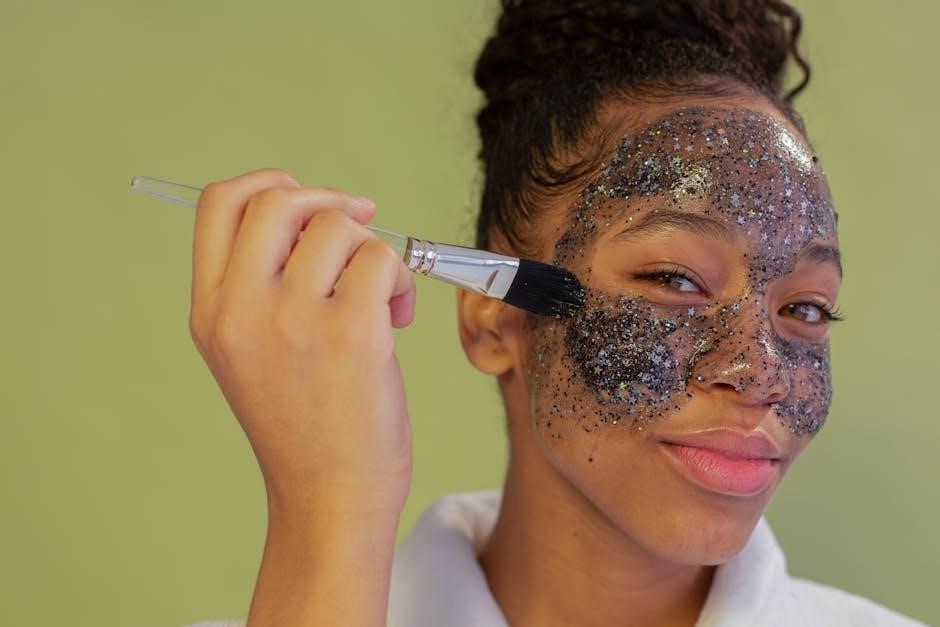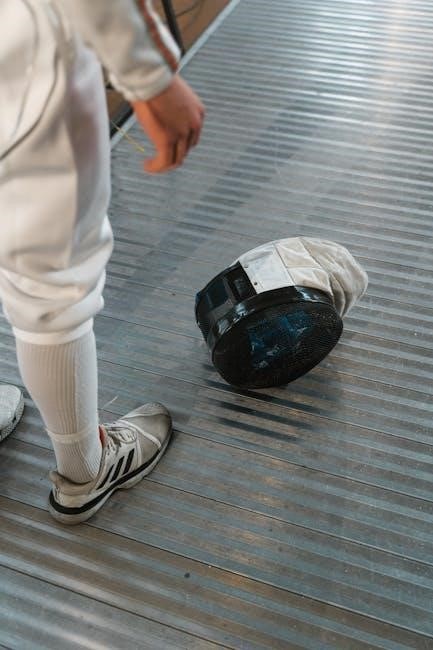Foot peel masks are innovative treatments designed to remove dead skin cells, revealing smoother feet. They often come in sock or serum form, featuring exfoliating ingredients like acids and fruit extracts. These masks are easy to use, promoting soft, refreshed skin with minimal effort. Ideal for at-home care, they’re perfect for achieving salon-like results without professional help, making them a popular choice for self-care routines.
1.1 What Are Foot Peel Masks?
Foot peel masks are topical treatments designed to exfoliate and soften rough, dry skin on the feet. Typically applied in the form of serums or sock-like booties, they contain chemical exfoliants like glycolic acid, salicylic acid, or fruit extracts. These masks work by gently breaking down dead skin cells, which then shed over several days, revealing smoother, refreshed skin. Many formulations also include hydrating ingredients to nourish and moisturize the skin after peeling, making them a popular at-home solution for achieving soft, healthy-looking feet.
1.2 Benefits of Using Foot Peel Masks
Foot peel masks offer numerous benefits, including the removal of dead skin cells, smoothing rough patches, and revealing softer, brighter skin. They are easy to apply at home, making them a convenient alternative to professional treatments. Regular use can improve foot texture, reduce calluses, and leave feet feeling refreshed. Many masks also contain hydrating ingredients to moisturize and nourish the skin post-peeling. This makes them an ideal self-care solution for achieving salon-quality results without the need for costly appointments or time-consuming rituals.

Key Ingredients in Foot Peel Masks
Foot peel masks typically contain exfoliating acids like glycolic and salicylic acid, along with fruit extracts and hydrating ingredients to gently remove dead skin and nourish feet.
2.1 Glycolic Acid
Glycolic acid, a type of alpha-hydroxy acid (AHA), is a key ingredient in foot peel masks. It works by penetrating the skin’s surface to break down dead skin cells, effectively exfoliating and smoothing rough patches. This ingredient is particularly effective at addressing calluses and hardened areas, leaving feet soft and refreshed. Its ability to promote cell turnover also helps in revealing brighter, healthier skin. Regular use can lead to long-lasting results, making it a popular choice for foot care routines.
2.2 Salicylic Acid
Salicylic acid, a beta-hydroxy acid (BHA), is another essential component in foot peel masks. Known for its ability to deeply penetrate pores, it effectively breaks down and removes dead skin cells, reducing calluses and rough patches. This acid also has antibacterial and anti-inflammatory properties, making it ideal for addressing cracked heels and preventing infections. By promoting cell renewal, salicylic acid helps achieve smoother, healthier-looking feet over time. Its gentle yet potent action makes it a valuable ingredient in foot care products, enhancing both the appearance and health of the skin.
2.3 Fruit Extracts
Fruit extracts are a common addition to foot peel masks, offering nourishment and hydration. Rich in antioxidants and vitamins, they help soften and brighten the skin. Citrus fruits like orange and lemon provide vitamin C, which enhances skin brightness, while berries such as strawberry and raspberry offer protective antioxidant benefits. These extracts work synergistically with other ingredients to promote healthy skin renewal, leaving feet feeling smooth and refreshed. Their natural properties make them a gentle yet effective component in achieving soft, rejuvenated skin with each use.
2.4 Hydrating Ingredients
Hydrating ingredients in foot peel masks are essential for maintaining moisture and preventing dryness. Common components include hyaluronic acid, shea butter, and aloe vera, which help lock in moisture and soothe the skin. These ingredients work alongside exfoliants to ensure that while dead skin is removed, the new skin remains soft and hydrated. Proper hydration supports the healing process and enhances the overall effectiveness of the peel, leaving feet feeling smooth and refreshed without irritation. They balance the exfoliating effects, ensuring a comfortable and nourishing experience.

Instructions for Using Foot Peel Masks
Soak feet, apply the mask or serum, and wear provided socks. Wait 1.5–2 hours, then rinse. Avoid moisturizing during peeling for optimal results and smooth skin.
3.1 Preparing Your Feet
Preparing your feet before using a foot peel mask is essential for optimal results. Start by washing your feet thoroughly to remove dirt and oils. Use a pumice stone to gently soften rough patches and calluses. Dry your feet completely, paying extra attention between the toes. Trim toenails to prevent irritation during peeling. Remove any nail polish to ensure the peel adheres properly. Avoid applying lotions or oils, as they can create a barrier. Finally, slip on the provided socks after applying the mask to retain moisture and promote even exfoliation.
3.2 Applying the Mask
Applying a foot peel mask involves a few simple steps. Begin by slipping on the provided socks or booties, ensuring they fit snugly. Pour the serum into the socks, making sure to distribute it evenly over your feet. Wear the socks for the recommended time, typically 1.5 to 2 hours, allowing the exfoliants to work. Avoid moving excessively to prevent the serum from spreading unevenly. After the treatment, remove the socks and rinse your feet thoroughly with warm water. Avoid using a washcloth or scrubbing, as the peeling process will begin naturally within a few days.
3.4 Caring for Your Feet After the Peel
After using a foot peel mask, keep your feet moisturized to enhance results. Avoid harsh soaps or scrubs, as the skin may be sensitive. Gently wash with mild soap and warm water. Wear comfortable shoes to prevent friction and callus formation. Avoid additional exfoliation for at least two weeks. Some brands advise against moisturizing during peeling, but once it’s complete, hydrate thoroughly. Be patient, as full results may take up to two weeks. Proper care ensures soft, healthy-looking feet and prolongs the benefits of the peel.

The Peeling Process
The peeling process typically starts within 3-7 days post-treatment, revealing smoother skin. It’s a gradual shedding of dead cells, often compared to a snake-like molt, and can last up to two weeks, depending on skin thickness and product potency. During this time, avoid exfoliating or using harsh products. The skin may peel in layers, with some areas shedding more than others. Patience is key as the process unfolds, leading to soft, rejuvenated feet. Proper care during this phase ensures optimal results and skin health.
4.1 What to Expect During Peeling
During the peeling process, dead skin cells shed gradually, often starting within 3-7 days after application. The skin may peel in layers or small flakes, revealing smoother texture underneath. Peeling can last up to two weeks, depending on skin thickness and product potency. It’s a natural process, and results vary per individual. Some may experience more noticeable shedding, while others have a subtler effect. Avoid picking at peeling skin to prevent irritation. Moisturizing after peeling helps maintain softness and hydration, ensuring the best outcomes for your feet.
4.2 How Long Does Peeling Last?
The peeling process typically lasts between 7 to 14 days, depending on skin type and product strength. Initial peeling begins within 3-7 days post-application, with most shedding occurring in the first week. After this period, skin gradually becomes smooth and even. Factors like foot thickness and product potency influence duration. Proper aftercare, including moisturizing, can help maintain results. Patience is key as the skin completes its renewal cycle, ensuring long-lasting softness and hydration for your feet.

Safety Precautions
Avoid using foot peel masks on open sores, abrasions, or sensitive areas. Patch testing is recommended. Discontinue use if irritation occurs. Consult a professional if unsure.
5.1 Contraindications for Use
Foot peel masks are not suitable for everyone. Individuals with open sores, eczema, or sensitive skin should avoid use. Those with diabetes or poor circulation should consult a doctor. Masks containing acids like glycolic or salicylic can irritate broken skin, leading to discomfort or infection. Avoid using if you have recent wounds or abrasions. Always patch test before applying to ensure tolerance. If unsure, consult a dermatologist or podiatrist for advice. Safe use ensures effective results without complications.
5.2 Avoiding Common Mistakes
To ensure safe and effective use of foot peel masks, avoid common mistakes. Overuse can lead to irritation, so stick to recommended frequency. Don’t apply on broken or sensitive skin, as acids can cause pain or infection. Avoid moisturizing during peeling, as it may slow results. Wear socks as directed, ensuring proper absorption. Don’t remove peeling skin forcibly; let it shed naturally. Follow instructions carefully and patch test first. Proper care prevents complications and enhances benefits, ensuring smooth and healthy feet after treatment.

Best Foot Peel Masks on the Market
Top-rated foot peel masks include BeautyPro, Beauty Pie, and Scholl, offering effective exfoliation and hydration. These masks feature powerful ingredients like glycolic and salicylic acids for smooth results. Choose My Mood for an affordable option with fruit extracts, ensuring soft, refreshed feet. Each product is designed for different foot care needs, providing visible improvements in skin texture and appearance. Explore these options for a salon-like experience at home, tailored to your specific foot care routine and preferences.
6.1 BeautyPro Foot and Callus Peel
BeautyPro Foot and Callus Peel is a top-rated option, praised for its effectiveness in exfoliating and hydrating. It features a serum-infused sock design, making application easy and mess-free. The formula combines powerful ingredients like glycolic and salicylic acids to gently remove dead skin and calluses. Users rave about its ability to leave feet smooth and callus-free. It’s ideal for those seeking a convenient, at-home solution for rough skin, offering visible results within days. This peel is a favorite for its ease of use and impressive outcomes, making it a must-try for foot care enthusiasts.
6.2 Beauty Pie Dr Glycolic Soft Feet 7-Day Peel Socks
Beauty Pie’s Dr Glycolic Soft Feet 7-Day Peel Socks are a premium choice, offering a luxurious at-home experience. These socks are infused with glycolic acid and nourishing ingredients, designed to gently exfoliate and soften rough skin over seven days. The formula works to remove dead skin cells, revealing smoother feet. Users appreciate the convenience and effectiveness, making it a popular option for those seeking long-lasting results. The socks are easy to apply and require minimal effort, perfect for achieving soft, sandal-ready feet without the hassle of frequent treatments.
6.3 Scholl Expert Care Exfoliating Heel Peel Mask
The Scholl Expert Care Exfoliating Heel Peel Mask is specifically designed to target tough, dry skin on the heels. It combines lactic, glycolic, and salicylic acids with nourishing fruit extracts to gently exfoliate and soften hard skin. The mask fits snugly around the heel, ensuring precise application. After use, the dead skin peels away, leaving the area smooth and refreshed. This peel is ideal for those seeking a focused treatment for stubborn heel calluses and dry patches, delivering noticeable results without irritation.
6.4 My Mood Walk On The Wild Side Foot Mask
The My Mood Walk On The Wild Side Foot Mask offers an affordable and fun solution for achieving soft feet. Priced under £10, it features vibrant leopard-print sock designs. The mask contains exfoliating acids and coconut oil for hydration. Simply wear the socks for an hour, then wait for peeling to begin within a week. It’s perfect for pre-holiday prep or casual use, leaving feet smooth and moisturized. This mask is a budget-friendly option for maintaining soft skin without compromising on effectiveness or style.

Comparing Foot Masks and Foot Peels
Foot masks focus on hydration, while foot peels prioritize exfoliation. Masks provide immediate moisture, while peels remove dead skin over time, offering distinct benefits for different needs.
7.1 Differences in Purpose
Foot masks primarily focus on hydration and nourishment, providing immediate moisture to dry feet. They are designed for quick, intense conditioning and are often used for relaxation. In contrast, foot peels aim to exfoliate and remove dead skin cells through chemical ingredients like acids, revealing smoother skin over time. While masks offer a pampering experience, peels target specific concerns like calluses and rough patches, making them ideal for long-term skin renewal and maintenance. Each serves a unique purpose, catering to different foot care needs and preferences.
7.2 Downtime and Results
Foot masks typically require no downtime, offering immediate hydration and softness that lasts a few days. They are perfect for quick refreshment. Foot peels, however, involve a waiting period as the skin peels, usually within 7–10 days post-application. Results from peels are more dramatic and long-lasting, with smoother skin remaining for weeks. Masks provide instant gratification, while peels deliver gradual, transformative outcomes. Choosing between them depends on your timeline and desired level of skin renewal, ensuring optimal results tailored to your foot care routine and preferences.

Maintenance and Aftercare
Regularly moisturize feet post-peel to maintain softness. Reapply masks monthly for sustained results. Avoid overuse to prevent irritation. Proper aftercare ensures long-lasting smooth, healthy-looking feet with minimal effort.
8.1 Keeping Feet Moisturized
After using a foot peel mask, it’s crucial to keep your feet hydrated to maintain softness and prevent dryness. Use a rich moisturizer daily, focusing on heels and calluses. Ingredients like hyaluronic acid, shea butter, or coconut oil help lock in moisture. Avoid harsh soaps or hot water, which can strip natural oils. Consistent hydration supports the skin’s renewal process, ensuring your feet remain smooth and supple long after the peel. Regular moisturizing also helps prevent cracking and callus buildup, keeping your feet healthy and ready for sandals or barefoot activities year-round.
8.2 Frequency of Use
Foot peel masks should be used every 2 to 3 months to maintain smooth, healthy skin without over-exfoliating. Overusing them can lead to irritation or dryness. After applying a peel, wait at least 7-10 days for the peeling process to complete before considering another treatment. Consistency is key, but patience is essential to avoid damaging your skin. Regular use helps prevent calluses and keeps feet soft, but always follow the recommended interval to ensure optimal results and maintain the health of your skin.
Foot peel masks offer an effective, easy way to achieve smooth, healthy feet. With proper use, they provide lasting results, making them a great addition to any self-care routine.
9.1 Final Thoughts on Foot Peel Masks
Foot peel masks are a simple yet effective way to achieve soft, healthy-looking feet. By following proper instructions, users can enjoy smooth skin and address calluses and rough patches. These masks are formulated with exfoliating ingredients like glycolic and salicylic acids, which gently remove dead skin cells. While peeling can take time, the results are worth the wait. For best outcomes, avoid overuse and moisturize afterward. With consistent care, foot peel masks can keep your feet feeling refreshed and revitalized all year round.